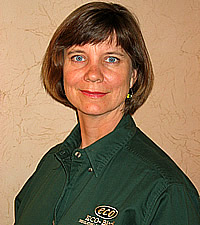- Staining Concrete
- Stamped Concrete
- Concrete Overlays
- Concrete Resurfacing
- Concrete Polishing
- Concrete Dyes
- Colored Concrete
- Indoor Concrete
- Concrete Floors
- Concrete Countertops
- Garage Floor Coatings
- Furniture, Sinks, Fire Bowls
- Basement Floors
- Outdoor Concrete
- Concrete Patios
- Concrete Driveways
- Concrete Pool Decks
- Outdoor Kitchens & Counters
- Outdoor Fireplace
- Concrete Walkways
- Concrete Pavers
- Concrete Walls
- Repair & Maintenance
- Foundation Repair
- Concrete Crack Repair
- Concrete Sealers
- Building with Concrete
- Concrete Homes
- Concrete Basements
- Decorative Concrete
- Fire Resistant
Vera Novak: Making Sustainable Design a Thing of the Present
Oct 2004 Industry Leader:
For Vera Novak--LEED AP, Environmental Specialist for ECO-Block, LLC-- sustainable design is not only a passion, she's also made her living spreading the word about its benefits. As the only environmental specialist in the ICF industry, she takes her role very seriously, especially where it relates to education.
"I'm driven by doing something beneficial for the earth," says Novak. "I believe promoting energy efficient ICFs is a really good thing for the environment." She adds that she's happy to have found a company who supports her endeavors, because they understand this also makes good business sense.
The fact that Novak is an environmental specialist focused on sustainable design may come as no surprise to those who know her well. After all, this is the same woman who, at the age of 21, designed her first sustainable home in Utah.
This is also the same woman who, while in Europe as the Director of the European Office of the State of Utah, devoured everything she could get her hands on related to Germany's Green Hotel and France's Green Tourism plans.
"I got a taste for it then," she laughs. "I came back from Europe, but sustainability carried over into my life." Novak carried a line of environmentally friendly products for interior finishes and says she was looking for something structural: "because I realized that sustainability needs to start with the skeleton (of the home)".
While Novak was volunteering on a job site of an Energy Efficient Model home sponsored by Utah State University, she learned to build with ECO-Block. "They were looking for a representative in Utah, so it was a perfect fit," she explains. "My own interest naturally led me to research the environmental aspects of the ICF block and the industry, which led to a position as environmental specialist."
But it wasn't until just recently that Novak started investigating the life cycle of a finished building, and she found that a mere two percent of total energy is expended in the building materials and construction phase and a staggering 98 percent of the energy used in the operational phase--energy used to heat/ cool and power the building.
Novak is emphatic that the bottom line is that we must save America's energy. And she knows how to do it. "Look at the Millennium House in Tulsa, Oklahoma," she says. "It's an Energy Star home, it meets the American Lung Association criteria, it's durable, it's affordable and it provides universal access. All of these elements create an optimal design for the future. The house proves we can create a sustainable, affordable home."
And there's an increasing demand for just that type of home. Novak says that more and more she's hearing consumers say that they want healthier, quieter, energy efficient, durable places to live. After all, as Novak says, "Once they taste successful green building, why choose anything else?"
She adds that not only are consumers interested, but architects and builders are as well. "Sustainable design has been around for years. The 70s oil crunch spurred science to develop solar panels and wind technology. There was a burgeoning interest but it was too alternative, and there were too many lifestyle compromises required. But behind the scenes, the research continued and the interest grew," Novak explains.
"Now, supporting the environment has again gained popularity. This time, it is packaged as a benefit, with few lifestyle sacrifices...it's more palatable, more attractive and has greater support from people in power and influence. This time, it is here to stay," she adds.
Novak says that concrete plays a big role in sustainable design, adding that concrete is a good thermal mass for passive solar; it reduces the heat island effect; permeable concrete is a solution to runoff problems; and concrete's durability is unmatched. Insulating Concrete Forms take the strengths of concrete and augment it with effective insulation.
Novak points out that the U.S. Green Building Council has an impact on the commercial side, because it helps the industry understand that sustainability has to happen at the design stage, thus changing the way buildings are designed and making the biggest impact.
Novak says that an integrated design process has to be the first step. Next, it's important to make the building integrated with the site, such as using and/or taking into account pervious pavement, shade, solar orientation and passive solar options. Then, choose materials with a view towards life cycle analysis. "In other words, we should be building homes that (at the very least) outlast their mortgages," she says
"It's collaborative design," explains Novak. "Working from the inside out instead of the outside in." She adds that since green building can be done on the same budget as non-green, most developers now say, why would I not want to go green?
"Now there's enough groundswell interest and enough success stories for it to really take root," Novak adds. "Building green is here to stay--this is our future."




